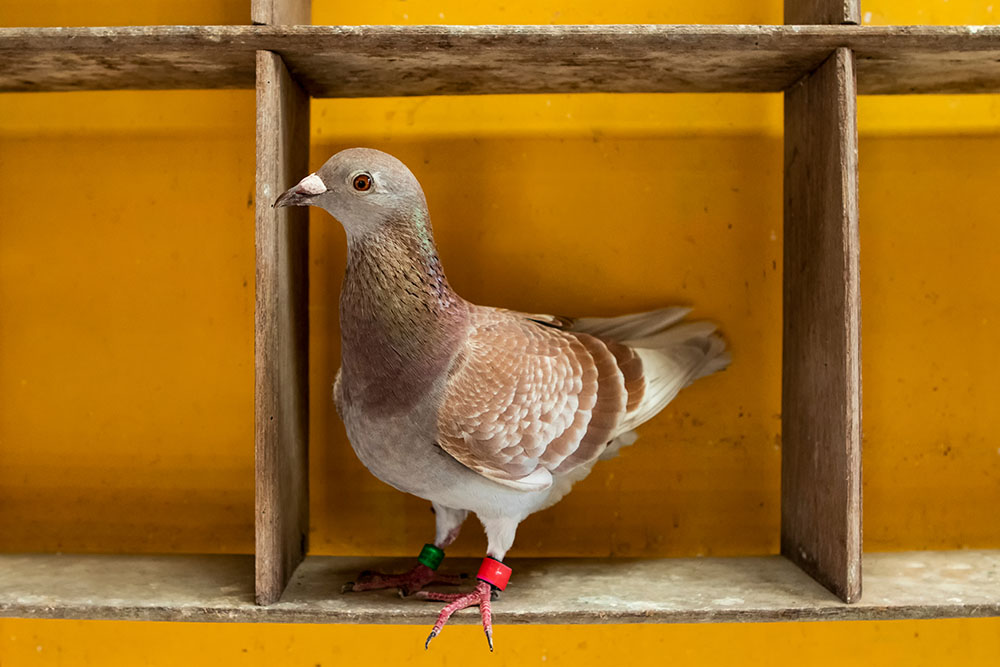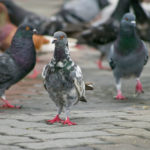How much is the life of a pigeon worth?
Often, that depends very much on how good it is at doing the things we as humans have bred it, taught it, or rewarded it to do.
If you invest in and train a thoroughbred racehorse, its value isn’t equal to the money you’ve spent to feed, train and maintain it.
Its value is equivalent to how much it can raise in prizes from winning races into which you enter it, or how much you can get if you put it out for stud.
If your thoroughbred racehorse took off like a rocket out of the gate, but then ran all the way out of the stadium, galloped into open country and was later found, confused, hungry and disoriented, the sad truth is that, while the horse might have a long and productive life with plenty of other owners, as a racehorse, its value would be done.

If returned to the owner, it would likely be humanely killed and disposed of as dogmeat.
Sadly, the same is true of most pigeons you find wearing leg bands.
The intervention that calls for them to have their legs banded can be one of two things. If the band is plain metal, they may well have been noted by conservationists.
Much more usually though, they are domestic racing or homing pigeons that have essentially done the equivalent of running out of the stadium – they have either become lost and disoriented, or become disinclined to make their way home.
While the investment in a racehorse means there’s at least some chance the horse, if returned to its original owner, might find a second life and career, because pigeons are relatively cheap to feed and train, a failed racing or homing pigeon is much more likely to be disposed of.
In fact, to some extent the disposability of pigeons is factored into the cost of doing business as a racing or homing pigeon breeder.
Once you let them go, it’s only a matter of their instincts kicking in whether they return or not, and in events like the deeply inadvisable dove releases that are a part of many ceremonies, the return of any of the ‘doves’ is figured to be unlikely.
So if you find a pigeon in the wild with its leg banded, the irony is that the alphanumeric information in the leg band should allow you to find the original owner.
The likelihood that they would a) want them back, and b) allow them an old age is relatively small, compared to the potential life expectancy they can expect if rescued.
‘Failed’ racing or homing pigeons are frequently advertised as surplus to requirements, and can be used for dog training or falconry – the implication of which is that they’re torn apart while training carnivorous animals in the art of the kill.
The Upside
While this sounds like a thoroughly bleak picture, it should be noted that some rescues issue bands of their own.
That means owners who do treat their birds well and would be prepared to continue to feed and maintain them if they were returned to them can get those bands.
If you check the band of a bird found in the wild and it has just a phone number, or the details of a rescue on it, the chances are you’re part of a relatively happy return story.
But it’s not always quite that simple.
Banded Pigeons – To Return Or Not To Return?
The truth is that there’s no hard and fast rule on returning any banded pigeons you find.
Some bands will have just the phone number of the original owner on, but returning the birds to that owner might – or might not – result in them living a long and happy life.
Any mention of pets or rescues on the band increases the chances of a positive outcome. But bottom line, you’re not alone when you find a banded pigeon in the wild. Take it to your nearest rescue.
That will have some history of dealing with returned and rescued birds, and the staff will have a better idea of the reality of what awaits birds returned to particular owners.
Either way, the rescue will be in a better position to ensure the bird has a happy future than you are yourself.
Clip-Ons
If you find a pigeon that has a simpler, clip-on band, you might at first glance think there’s more hope for these birds to be returned to owners, because the band is less strongly attached.
Sadly, just the opposite is true. If you find a bird with a blank clip-on band, the likelihood is that you’ve found what’s called a “meat pigeon.”
The analogy there is not to our escaped racehorse, but more to a battery chicken. Meat pigeons rarely leave their breeding coop until they’re on the way to the butcher.
That means on the one hand, you’ve rescued a pigeon from the dinner table.
On the other, the blank, clip-on bands are completely untraceable – they have the personality of a lug wrench – and so there’s no hope of finding out who was responsible for the bird in the first place.
Second Place Is First Loser
If you find a racing pigeon with a band, it’s very unlikely to be a good idea to return the bird to its original home.
Why? Because of the mentality we explained – if you’re a racing pigeon that doesn’t win, you’re more or less a waste of feed.
The likelihood of a racing pigeon going home and being looked after as they would be at a rescue is very small indeed. It’s simply not economical for the owner to do it.
If you imagine the birds not as birds per se but as chattel, they have to earn their keep, and a racing pigeon that either doesn’t or won’t race successfully and win is a liability.
It’s also worth remembering that whatever the conditions in the original owner’s pigeon coops are, if you find a pigeon in the wild that has been raised in domestic captivity, it is likely going to be in distress, because it won’t have the skills it needs to survive in the wild.
It may well be undernourished or dehydrated, it may have picked up diseases or ticks.
In fact, if you try to return the bird to the original owner at that point, you’re handing them not only the liability they originally were by virtue of not winning their race or homing in good time – you’re handing them additional veterinary bills and a potential liability for the rest of the coop.
Result? Very likely at least one dead pigeon.
The Fairy Tale Factor
We understand the urge is strong, when you find a pigeon in the wild with a leg band that lets you know who its original owner was, to return it to that owner.
It feels like the pigeon equivalent of a “Happily ever after” ending, the bird, after being lost in the wild, returned to its cosy coop and its pigeon friends.
Be aware of the complexity. There are very few “Happily ever after” endings for pigeons returned to their original owners, for the reasons we’ve just explained.
It’s economically not viable for the owners to take them back, or to keep them alive for long once evidence of their failure to perform has been established.
In a different analogy, don’t think of the birds as birds, think of them as racing cars.
If you find one in the wild, it’s the equivalent of a once-fine racing car, now rusted, rain-soaked, and with mice making babies in the seats.
You can return that to the original owner, absolutely.
But the likelihood that they’ll either thank you for doing so, or keep the rustbucket alongside their shiny winning race cars for very long, is vanishingly small.
Pets And Banding
Once more for the people at the back: if you have a pet pigeon – or a pet dove, for that matter – you should not be letting them fly around loose.
Why?
Because they’re pets, and unlike other domestic pet animals like dogs or cats, in the wild, they’re much more likely to be prey than predators.
So if you feed them at home, they won’t know how to find their own food when allowed to fly free.
They also may not (unless they’re adept at homing) know how to come back to you.
And the environment into which you’re letting them loose is potentially a natural warzone of hazards for them. It’s like letting a pet mouse loose in a cattery.
Yes, you can argue that banding them means if they get into trouble, well-meaning humans can return them to you, but the point is that they shouldn’t be flying wild in any case once they’ve been domesticated, so the banding is the equivalent of setting an honest man loose in a prison with a MedicAlert bracelet on.
If you’re going to band them, use a band from a local rescue, so everyone has a clear pathway to help in the event that it’s needed.
Freeing Birds From Bands
Depending on the kind of band around the leg of the bird you find, you can potentially free it yourself, but be careful – there are various types of band, and some will need professional veterinary help to break.
If your bird has a clip-on band, it should be easy to open and remove by hand without endangering the bird.
If your bird is wearing a closed band, be very careful. Do not under any circumstances try to pull the closed band off the foot of the bird.
It will have been attached with the bird (and its feet) were much younger and smaller.
Yes, effectively, it’s a manacle the bird grows into. If you try and remove it over the end of the bird’s foot by the time you find it, you’re guaranteed to fail, and fairly certain to break the bird’s foot in the process.
The way to free your bird from a closed band is with a pair of cuticle clippers – ideally, the heavy-duty ones.
They can snip through the band, though it usually takes several cuts, and you can free the bird that way, carefully sliding in between the bird’s leg and the band.
Bear in mind, this will in no sense of the word be easy.
The bird will likely be distressed, and you’ll be trying to remove something that may well, as far as its memory is concerned, be a vital part of its anatomy that it’s had as long as it can remember.
Good luck and perseverance are the order of the day when freeing a bird from a closed band.
In the unusual, but not unheard-of, event that your bird has a hard metal band, let’s cut to the chase here – you either don’t possess the tools to free the bird from its band, or if you do, you’re likely to be lacking some crucial skills.
You’re going to need a qualified avian veterinarian with some experience of calming distressed animals.
Many more savvy avian veterinarians with a history of dealing with banded birds will actually keep a cutting tool like a Dremel in their surgery.
More to the point, they will have the experience needed to keep the bird calm while they carefully cut through the metal band.
We cannot stress how important it is to handle this correctly – for a bird, a leg injury can be catastrophic, because swelling can lead to a loss of blood flow, and potentially the loss of a foot.
So, seriously – if your bird looks to have a metal band, get them to the avian veterinarian. Do not, as the saying goes, try this at home.
Bottom Line
If you find a pigeon or a dove out in the wild and they have a band on their leg:
- Check the data on the band. If it has details of a particular rescue, take the bird there (or to your nearest rescue, as the staff there may be better equipped to deal with the rescue on the band).
- If the data does not specify a rescue, check the band. If it’s a clip-on, it can be removed by hand. If it’s a closed band, it can be removed with heavy-duty cuticle clippers. If it’s a metal band, take it to your nearest avian veterinarian for professional removal.
- Ideally, take the bird to your local rescue, rather than necessarily obeying your fairy tale instinct to reunite the bird with its previous owner. The rescue may be able to make a more informed judgment call on whether such a return is at all safe or desirable.






